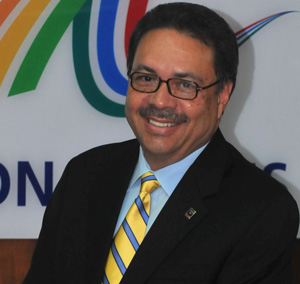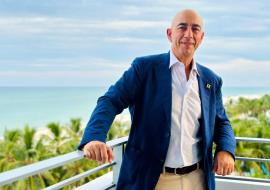Simon Suarez, President of Asonahores

We sat down his Simon Suarez, President of Asonahores, who gave us details on the improvement of the Dominican Republic’s hotel industry. Mr. Suarez also assessed the challenges and opportunities for the Caribbean within the context of the shifting relations between Cuba and the United States.
When were you appointed President of Asonahores?
I was elected in August 2014. I took office in September for a two-year term and ever since I’ve been working to give Asonahores an interesting turn in such a favorable moment, since the tourism activity has experienced a global boom, specifically in the Caribbean and the Dominican Republic is doing very well.
Do you hold any other position, beyond chairing Asonahores?
Along with my responsibility in Asonahores, as president of the Volunteers Group, I’m the vice-president of Institutional Relations and New Projects with Punta Cana Group.
What’s the new forward-looking approach of the Dominican Republic and its hotel business after the updating of its hotel infrastructure?
Right now we’re focused on regionally expanding the tourism activity and, furthermore, aiming the product at new niches and opportunities. As for geographical diversification, as a result of the improvements in terms of the road infrastructure, the east zone will be linked with Samaná by means of a ferry in Sabana del Mar. That’s one of the projects that we’re going to develop over the next years.
We also have the south opening. This area is being given an important road network to favor its integration to the rest of the Dominican Republic from the tourism point of view. New projects are being developed at the southern region. There are two projects at the Baní zone, for instance: one combines the real estate activity with a very-interesting viniculture development. On the other hand, we have Los Corbanitos project on a gorgeous beach of white sand right in front of Salinas Bay, Calderas Bay.
Furthermore, the government has just announced the approach to Pedernales zone, where territorial ordering and tourism development plans have been drawn up, as well as a trusteeship that is being structured to capitalize projects in that area.
Are you going to use trusteeships and clusters as part of that development?
Yes, definitively. The clusters system is already pretty-well developed and structured in the Dominican Republic and the results are there. The main clusters have been working on the repositioning of such destinations as Puerto Plata, Cabarete and Samaná.
There is one cluster at the Barahona zone, Pedernales, which is going to have more activity as capital resources are sent to the south region.
The possible end of the embargo against Cuba, what does the Dominican hotel industry make of it?
There are several opportunities and one of them is establishing closer ties between the Dominican Republic’s investing sector and Cuba. Many Dominican Republic-based investors have always been interested in working with Cuba, but they haven’t been able to do it due to different reasons. That integration activity shall take place and that’s very interesting.
On the other hand, the North American market that travel to the Caribbean is going to be shared and that’s not positive, but it will be an incentive for the Dominican Republic to strengthen its position in the US market. How to do it? So far, we’ve been very successful with the east coast North American markets. Now we have to go into the country. We have to move to the mid-west and far-west. We already have the airport infrastructure to do so, with nonstop connections, for example, from Denver, Minneapolis and Chicago.
Now we have to attract those markets and strengthen our position, just as we have done in Boston, New York or Miami.
Do you think that the opening of Cuba to the US market could be an important advertising element to the Caribbean?
That’s the challenge to be faced by the rest of the Caribbean. I do think so, of course, because as soon as the Caribbean is put on a level with Cuba and Cuba becomes the new attraction, we will definitively have to be capable of drawing that attention to the Caribbean.
Could you mention three advantageous aspects in the Caribbean and Cuba when it comes to attracting the US market?
Mystery is the first attraction in Cuba, the fact that there are practically three generations of US citizens that know nothing about Cuba. That’s an interesting fact, because you have the history of Cuba, the United States – Cuba. As for the rest of the Caribbean, this is challenge that requires market positioning work.
Another attraction in Cuba is their clear structure of long-term strategic planning. Cuba has already defined its priorities: the areas they are going to develop with the aim on the North American market. That’s very positive because the interest US investors could have in Cuba will receive a fast, precise and clear answer: here and in these terms.
That entails a potential conflict as there is a significant presence of investors in Cuba, who are not going to accept the different terms Cuba is going to offer to attract that US investment. Cuba is to work it out.
Then you have the matter of how the North American industry is going to deal with the Cuban product. US hotel companies know nothing about Cuba, about hotel operations in Cuba, facilities, infrastructure and all those elements. They ignore several aspects. That would be risky because they could try to apply formulas that don’t work in Cuba. We’ll see how these matters are solved out, because there are positive and negative aspects.
How about the three advantage points in the Caribbean?
The Caribbean is already positioned in the United States. The fact that there is more exposure of the Caribbean is positive and the Jamaicas, Dominican Republics, Barbados and Antiguas of this world will have to make the most of this movement. The English-speaking Caribbean is very important to US travelers and that’s another advantage point.
All in all, we have great diversity and Cuba is now a part of it, but the Caribbean had it. The Caribbean has always featured that cultural diversity, the assortment of products beyond sun and beach, and all these elements can be boosted if we get the opening of Cuba and the attention of the US market on that product, translated into greater visibility to the Caribbean as a whole.
Do you think that this opening of the US market to Cuba could have an impact on a new approach of both CTO and CHTA on the Dominican Republic, Cuba or Mexico?
I believe that CHTA and CTO, specifically CHTA because I know it better, has to redefine itself once again as a more-dynamic organization, more focused on the needs of its members. It will also have to define the way it attracts the big players, because it has gone isolated with the smallest players of the area. Cuba was a member of CHTA for a long time. We have to see how CHTA re-attracts the Spanish-speaking Caribbean and the Caribbean of big destinations.
So you think that would be better than independently coming together.
I think so, because I don’t see a will to created new institutions. If CHTA is capable of reinventing itself, I think that would be easier and actually more efficient than creating a parallel organization with a definition that’s not clear yet.














